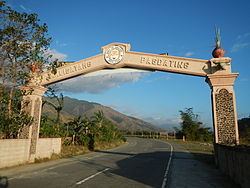Country Philippines Barangays ZIP code 3131 Population 32,246 (2010) Province Nueva Ecija | District 3rd District Time zone PST (UTC+8) Area 242.9 km² Local time Thursday 7:55 PM Dialling code 44 | |
 | ||
Region Central Luzon (Region III) Weather 20°C, Wind E at 16 km/h, 80% Humidity | ||
Stone 8 resort
Gabaldon (formerly Sabani and Bitulok) is a third class municipality in the province of Nueva Ecija, Philippines. According to the 2010 census, it has a population of 32,246 people. Tagalogs and Ilocanos predominate this town.
Contents
- Stone 8 resort
- Map of Gabaldon Nueva Ecija Philippines
- Dupinga river gabaldon nueva ecija tanawan waterfall dingalan aurora
- Barangays
- History
- References
Map of Gabaldon, Nueva Ecija, Philippines
The town is tucked between the Sierra Madre Mountains. It lies 171 kilometres (106 mi) north-east of Manila, the capital of the Philippines. It is bounded by Bongabon on the north, Laur on the west, General Tinio on the south, and Dingalan by the east.
Dupinga river gabaldon nueva ecija tanawan waterfall dingalan aurora
Barangays
Gabaldon is politically subdivided into 16 barangays.
History
Gabaldon was the site of the Sabani estate, the largest hacienda in Nueva Ecija during the second half of the 19th century, with 3,000 heads of cattle and occupying more than 6,000 hectares. The entire area was then part of the township of Laur. In 1950, the barrios of Bitulok, Bantug, Bitulok Saw Mill, Cuyapa, Macasandal, Pantok, Calumpang, Malinao, Tagumpay, Bugnan, Bagong Sicat, Ligaya, Calabasa, Bateria and Pintong Bagting, then belonging to the town of Laur, were separated to constitute the new town of Bitulok. The name was later changed from Bitulok to Sabani. Finally, through Republic Act 1318, approved June 16, 1955, its name was changed from Sabani to Gabaldon.
In December 1941, during the Second World War, the municipal town hall was burned down and the town was destroyed by the invading Japanese forces. Japanese bombers and fighter planes bombed villages that include nipa houses, ancestral houses, Roman Catholic churches, plazas. In 1942, the occupying Imperial Japanese armed forces established their main general headquarters, garrisons, camp bases, military and civilian POW barracks and local civilian internment camps. From 1942 to 1944, some of all the ongoing local soldiers of the Philippine Commonwealth military and aided the helpful of the Novo Ecijano guerrilla resistance and the Hukbalahap Communist guerrillas was the invaded the municipal town of Gabaldon during the Japanese Insurgencies and Occupation and attacking Japanese Imperial forces. The headquarters of the Imperial Japanese Armed Forces was built of the military garrisons and camps here the town of Gabaldon around the municipal halls, plazas, Roman Catholic churches and plains during the Japanese Occupation. The all local Novo Ecijano outgoing guerrillas and non-combatant civilians was arrested, tortured, marches and killed by the hand of the Japanese Imperial forces. The all local civilians were tortured by the Japanese hands at the Japanese military general headquarters, garrisons and local civilian internment camps in Gabaldon.
The town was recaptured in 1945 through siege and military raids by the local Filipino soldiers and guerrilla fighters stationed in the municipality of Gabaldon, the liberation of the stronghold of the local soldiers of the Philippine Commonwealth armed forces under the 2nd, 22nd, 25th and 26th Infantry Division was sending military operations around the municipal towns in the province of Nueva Ecija from the local P.C.A. military general headquarters and military camps in the province of Nueva Ecija in Central Luzon and aided the Novo Ecijano guerrilla resistance and the Hukbalahap Communist guerrillas was liberated and recaptured the municipal town of Gabaldon, Nueva Ecija and defeated Japanese Imperial armed forces and ended World War II.
